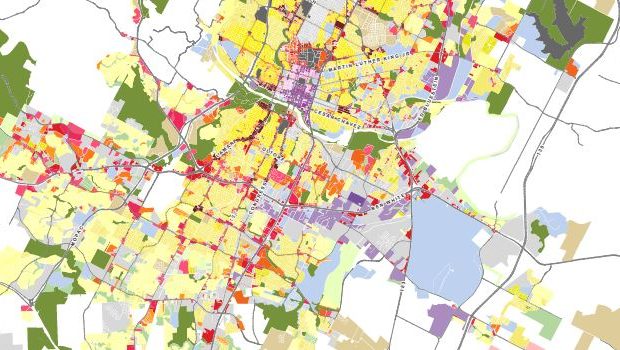CodeNEXT draft boosts housing capacity
Thursday, February 15, 2018 by
Jack Craver A day after the third version of CodeNEXT was unveiled, City Council members expressed cautious optimism about the proposed overhaul of Austin’s land development rules.
Notably, Council members were happy to see that the new version dramatically increased the amount of housing capacity. The second draft would have allowed for 145,000 new units to be built in Austin, while the third draft will roughly double the capacity to 287,000.
200,000 of those potential units would come from the base zoning. Another 87,000 are available if developers were to make use of the density bonuses proposed for the code. If the bonuses are exercised, 6,000 units would be “affordable”: restricted to either renters at or below 60 percent of the median family income or homeowners at or below 80 percent MFI.
Some of the ways the proposed code would increase housing capacity are by significantly increasing the number of residences that can add an accessory dwelling unit (or garage apartment) and allowing residential development on a large number of properties that are currently zoned only for commercial use.
Not only does the third draft propose far more city land to be eligible for density bonuses that would lead to income-restricted units (30,000 acres compared to 5,600 presently), more of the eligible areas are located in “high-opportunity” areas of the city that are characterized by easy access to job centers, transit and other key amenities. Trying to spread affordable units throughout the city, to promote mixed-income neighborhoods, has long been one of the city’s stated priorities.
The amount of housing that is actually built may not come close to the maximum capacity. But many housing advocates have said that the key first step to adding housing – including affordable units – is to at least provide the zoning that would allow it to be built.
Council Member Greg Casar said he was pleased to see the affordable unit capacity increase from 1,500 to 6,000, but noted that even the higher number would not come close to addressing the city’s dire shortage of low-cost housing. The Strategic Housing Blueprint called for 40,000 affordable units.
Casar also said he would like to see an even greater dispersal of new housing.
“I think currently looking at the housing capacity map, it doesn’t look fully balanced between gentrified areas and high-opportunity areas,” he said.
Council Member Ora Houston similarly expressed concerns that much of the new housing capacity appeared destined for her rapidly gentrifying east side district.
Council Member Delia Garza said she felt that not much additional capacity was being proposed for areas of the city west of Interstate 35.
“I have concerns that we’ve stepped away from providing more housing options in our neighborhoods,” said Garza.
Those who tend to express concerns about maintaining the character of single-family home neighborhoods seemed happy with some of the changes that bothered Garza and others who are more focused on increasing housing stock.
Mayor Pro Tem Kathie Tovo applauded the draft for offering better “alignment with existing zoning and neighborhood plans” and “increasing the amount of density by directing it to our corridors.”
Council Member Alison Alter similarly voiced optimism: “At first glance, it appears we’re in a better place.”
In a significant win for urbanists, the proposed code also reduces the minimum number of off-street parking spots for residences from two to one. ADUs will no longer have any parking requirement.
Mayor Steve Adler, who last year said he wanted CodeNEXT to reflect a compromise between increased housing and preservation of existing neighborhoods, said that the new draft showed that the consultants had been listening to the community’s desires.
“At a really high level,” he said, “it appears as if this process is moving forward to getting us closer to the Austin that we all want.”
Map courtesy of the city of Austin.
Curious about how we got here? Check out the Austin Monitor’s CodeNEXT Timeline.
The Austin Monitor’s work is made possible by donations from the community. Though our reporting covers donors from time to time, we are careful to keep business and editorial efforts separate while maintaining transparency. A complete list of donors is available here, and our code of ethics is explained here.
You're a community leader
And we’re honored you look to us for serious, in-depth news. You know a strong community needs local and dedicated watchdog reporting. We’re here for you and that won’t change. Now will you take the powerful next step and support our nonprofit news organization?









